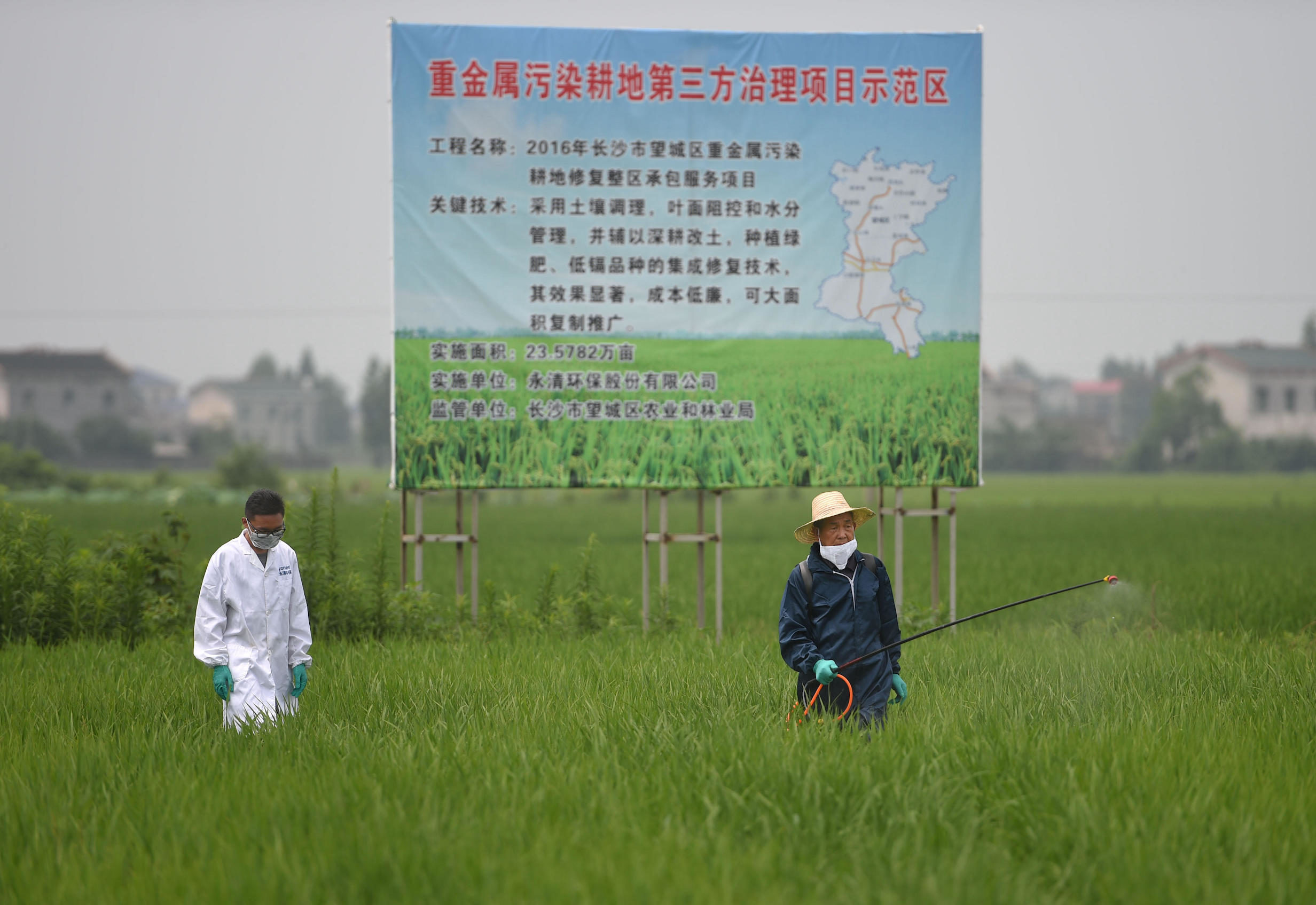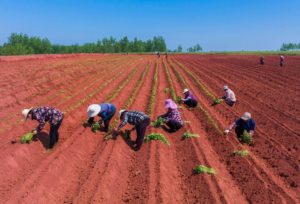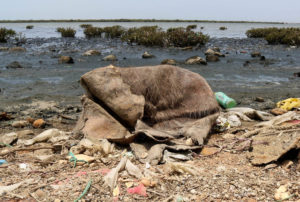In February, the State Council announced that a survey of China’s soil would be carried out, 40 years after the last one. It will take almost four years to complete, with preparatory works and trials already underway and its conclusion scheduled for the second half of 2025.
Reflecting its importance, the survey team will be headed by the vice premier of the State Council, Hu Chunhua, with deputy posts occupied by leaders of the Ministry of Natural Resources and the Ministry of Agriculture and Rural Affairs.
Those who work on soil issues have long hoped for a new study, with well-known soil scientists calling for one as early as 2005, at the government’s annual Two Sessions meetings.
The last four decades have seen rapid, resource-intensive economic growth in China. Chinese people enjoy a better quality of life now, but the soil has paid a heavy price. A new survey is essential for understanding and protecting soils, and it will help ensure food security and progress towards China’s peak carbon and carbon neutrality targets.
China’s soil surveys
Since the birth of modern soil science in the late 19th century, we have gradually come to understand that life on land, and even in the sea, depends on the topsoil, which covers much of the Earth at an average depth of 18 centimetres. On a planet with a radius of 6,371 kilometres, that is proportionally thinner than an eggshell. But this thin layer teems with microorganisms of incredible range and richness. It is home to over a quarter of our planet’s biodiversity. Organisms in the soil drive the planet’s metabolism, breaking down waste, as well as helping to provide food, energy, clean air and water.
We have also come to know that it takes centuries to build up a single centimetre of soil, and far less time to damage it.
China has carried out two national soil surveys since 1949, and two studies of soil pollution. The first survey ran from 1959 to 1961 and tried to calculate how much arable land China had, to identify where it was, and to create a soil classification system.
The second was of wider scope and more detailed. But the scale of the job and problems with transportation and working conditions meant it took two decades to complete, between 1975 and 1994. The first three years involved technical planning and trials, the survey itself ran from 1979 to 1984, and the results were processed between 1985 and 1994.
That survey took a “bottom-up” approach, with samples taken at the county level and results fed upwards. For the first time, China had a clear picture of its soil types, quantities, distribution and conditions. A soil classification system was created and reference materials and images produced. The proportion of low- and medium-yield land was identified, as were the obstacles to making that land more productive. Over the following decades, the data helped support agricultural development, the creation of arable land, the improvement of poor-quality land, fertiliser application and agricultural planning.
As for the two surveys of soil pollution, the first was of soil in general while the second focused on agricultural land. The first covered around 6.3 million km2 and its result were published in a report in 2014. Pollution was found to breach standards at 16.1% of the sampling sites. Inorganic pollution – such as cadmium, mercury, arsenic, copper, lead, chromium, zinc and nickel – was found at 82.8% of polluted sites. Organic pollutants, such as DDT, were the next most common. Comparison with the results of the second soil survey indicated that three decades of rapid economic growth had also meant rapid pollution of China’s land.

In 2018, results were published from the survey of pollution of agricultural land, which again warned of pollution risks in some soil.
Those investigations provided plenty of data, but as Shen Renfang, a member of the National People’s Congress and head of the Nanjing Institute of Soil Science, said: “The second survey was 40 years ago. There have been huge changes in how China uses its arable land, and in the nature and profile of land used for agriculture.” And China – short on arable land, large in population – uses too much fertiliser: 33% of all that is produced globally, despite having 8% of the world’s arable land. That causes acidification and dense, hardpan soil.
Hence many soil scientists had for years been calling for a third survey, particularly those who are representatives to China’s top legislature, the National People’s Congress (NPC), or its top political advisory body, the Chinese People’s Political Consultative Conference (CPCCC).
Forty years of change
Alongside the four major surveys, there have been some smaller scale or localised studies and monitoring. Viewed together, the data tell us there have been at least three changes in China’s soil over the past four decades.
1. Worsening heavy metal pollution
Take cadmium as an example. A priority soil pollutant in China, it harms the liver and kidneys and has a long half-life in the human body. In the 1960s, residents of Japan’s Jinzu River basin suffered mass poisoning due to eating rice contaminated with cadmium. According to Background Levels of Elements in China’s Soil, in 1990 average cadmium levels in China’s soil were 0.097 milligrams per kilogram (mg/kg) – very close to the background level. By 2009, a study by Chinese scientists found that cadmium was going into China’s topsoil at around 0.004mg/kg per year. At that rate, it would take only 50 years for cadmium concentration to exceed the national standard of 0.3mg/kg.
In China, cadmium in soil mainly comes from atmospheric deposition of the metal after it has been emitted from coal-burning, metallurgical facilities and animal-source fertilisers. Despite worsening levels over decades, some work to combat heavy metal pollution has begun to yield results; a 2013 initiative to tackle air pollution and strict controls of cadmium content in zinc-containing animal feeds have brought sources of cadmium contamination under control.
2. Rapid acidification
A paper published in Science in 2010, by a team led by Zhang Fusuo of the Chinese Academy of Engineering, found that over the course of 20 years, pH levels in China’s arable soils had fallen by an average of 0.5, meaning a 2.2-fold increase in acidity. Even calcareous soils – lime or chalky soils mostly composed of calcium carbonate, considered to be relatively immune to acidification – saw significant drops in pH levels. The paper points out that soils acidify very slowly under natural conditions, over hundreds to millions of years. The rapid acidification in China has been caused by acid rain and the large quantities of fertiliser applied during intensive farming.
Acidification increases the amount of toxic heavy metals absorbed by crops. The combined impact of acidification and heavy metal pollution is a threat to China’s food security and safety.


3. Changes in organic content
Organic carbon content is one of the best measures of soil fertility. During the 1980s, organic carbon stores in the top 20cm of China’s farmland were already low: between 26.6 and 32.5 tonnes of carbon per hectare, according to calculations based on figures from the second soil survey. This was much less than the average 43.7 tonnes found in US farmland, or 40.2 tonnes in Europe. While there have been regional variations, the last 30 years have seen levels of organic carbon in soil rise, thanks to the ploughing in of straw, the popularisation of low- and no-till farming, and the use of green manures and compost. Average organic carbon levels in arable land have increased by 24.49%, since the second soil survey. And organic carbon levels have increased significantly in 22 provinces, particularly in Anhui, Hunan, Guangxi, Sichuan and Guizhou. But the intensive use of land in China means levels remain low compared to those found overseas.
The significance of the new soil survey
When compared with the rest of the world, China’s soil is lacking both in quality and quantity. And, after four decades of intensive agriculture, the findings of the second soil survey no longer reflect the state of China’s soil.
Moreover, the 14th Five Year Plan and China’s Vision 2035 – to “achieve socialist modernisation” – both require China’s food security to be guaranteed, with the strictest possible measures to protect arable land, and a two-pronged strategy ensuring that both the required land and technology are available.
And so a new soil survey is both necessary and keenly awaited. Its results will help to achieve two major aims. First, to promote the health of the soil and help ensure an adequate and safe supply of food. Second, healthier soil will also sequester more carbon, helping China work towards its 2030 peak carbon and 2060 carbon neutrality targets.
Food security
The new soil survey will examine China’s arable land, orchards and plantations, forests and grasslands, as well as some currently unutilised land. In forests and grassland, the focus will be on areas used for food production. The study of unutilised land will concentrate on areas that could be made useful, such as saline-alkaline soils. On arable land, orchards and plantations, 45 tests will be carried out on each sample. There will also be surveys of animals and microorganisms living in the soil at those points.
The tests cover the physical and chemical properties of the soil and its nutrients. That data will help improve the soil and promote the shift to green agriculture and high-quality development. It will be of strategic importance for ensuring food security, food safety, rural incomes, the drive for “ecological civilisation”, promoting rural revitalisation, and supporting a new era of high-quality development.
Carbon sequestration
The soil is the largest terrestrial store of organic carbon. It contains three times as much as the 830 billion tonnes found in the atmosphere, and 240 times as much as the 10 billion tonnes emitted by fossil fuel burning every year. An increase of only a few percentage points would sequester huge quantities of carbon. Research has estimated that the soil could keep from the atmosphere the equivalent of 23.8 billion tonnes of CO2 equivalent every year – 40% from protecting existing carbon, and the remaining 60% from rebuilding depleted stores. This represents 25% of the potential of all natural climate solutions.
Soil can both be a source of greenhouse gas emissions, by releasing carbon dioxide and methane, or it can fix organic carbon. Reducing soil emissions and increasing carbon sequestration is therefore of huge importance for mitigating climate change. This led France to propose the 4 per 1,000 Initiative at the 2015 Paris climate talks, aiming to increase the amount of carbon stored in the top 40cm of soil by 0.4% each year.
China has not yet signed up. Some say this is because its current soil carbon fixing rate is only half of the 0.4% target of the initiative. We believe it’s because there are numerous soil types in China, and understanding their carbon-fixing potential requires more research.
China uses a 10-grade classification system for cultivated land, with grade 1 being the best. According to a 2019 report, the average grade is 4.76, two thirds of all soil is of low or medium quality, arable soil quality is low and the soil layer thin, and land is continuing to degrade. Organic carbon content in China’s soil is more than 30% lower than the global average, and less than half that in Europe. But that also means there is huge potential for carbon sequestration.
And there is already a high-level policy framework in place. In late June, the Ministry of Agriculture and the National Development and Reform Commission published a proposal for emissions reduction and carbon sequestration in agriculture and rural areas. One of the six major aims was to expand carbon sequestration in farmland, and one of the ten major actions to be taken is “increase farmland carbon stores”, which will focus on increasing organic carbon content.
The new soil survey does not have any specific targets or tasks relating to soil’s carbon sequestration abilities. However, it will test for organic carbon and calcium carbonate (an inorganic form of carbon). This will help calculate stores of carbon in different types of soil, and estimate future potential, as well as lay a foundation for the application of carbon sequestration techniques in the future.
Adding carbon to the soil is a win for both carbon neutrality and soil health. We hope that, on completion of the new soil survey, soil carbon sequestration will be included in official documents on agricultural emissions reduction and carbon storage, with specific targets, tasks and solutions.








